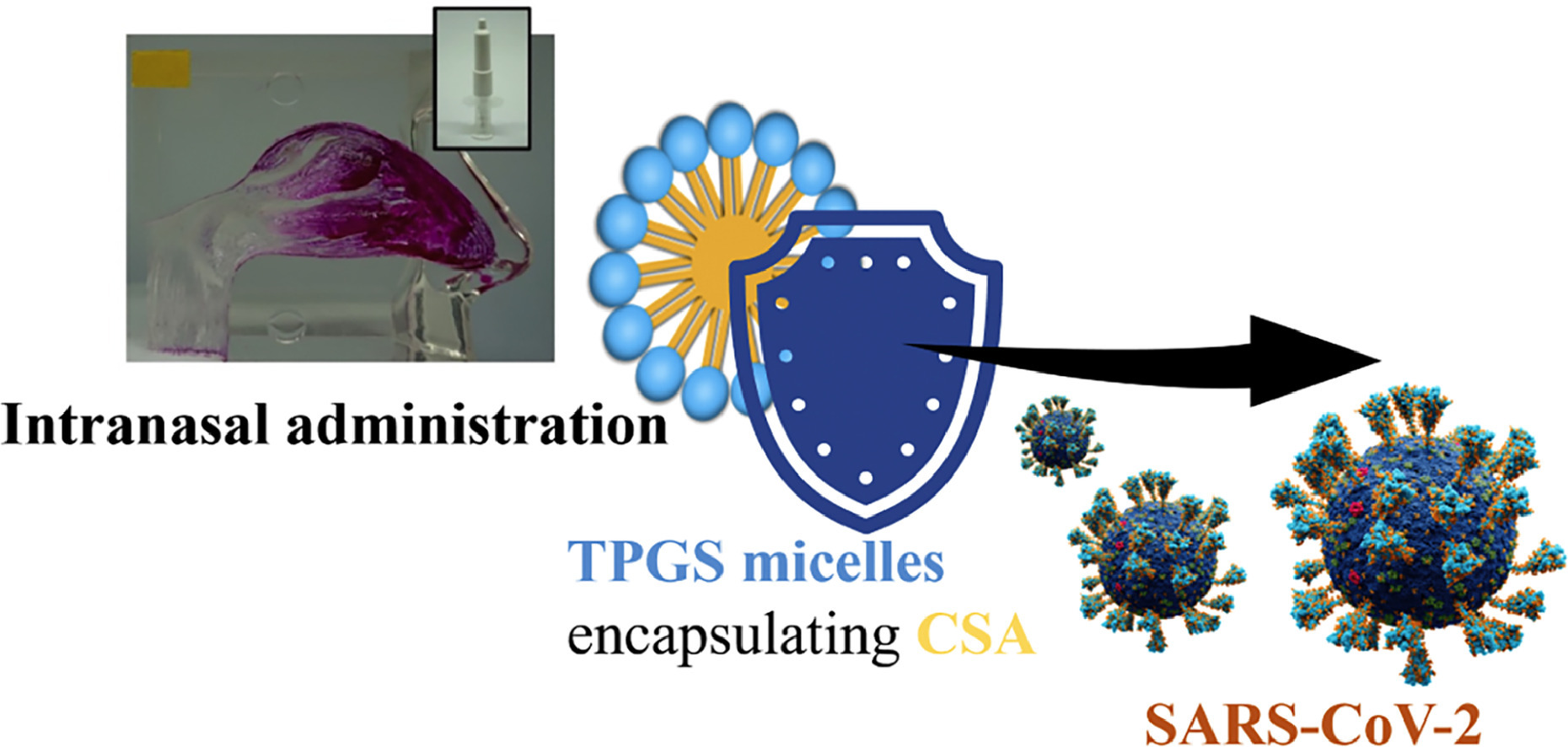Cyclosporine A micellar nasal spray characterization and antiviral action against SARS-CoV-2

The upper airways represent the point of entrance from where Severe Acute Respiratory Syndrome Coronavirus 2 (SARS-CoV-2) infection spreads to the lungs. In the present work, α-tocopheryl-polyethylene-glycol succinate (TPGS) micelles loaded with cyclosporine A (CSA) were developed for nasal administration to prevent or treat the viral infection in the very first phases. The behavior of the micelles in presence of simulated nasal mucus was investigated in terms of stability and mucopenetration rate, evidencing long-term stability and fast diffusion across the glycoproteins matrix. Moreover, the spray characteristics of the micellar formulation and deposition profile in a silicon nasal model were studied using three nasal spray devices.
Highlights
- TPGS micelles encapsulate cyclosporine A with high encapsulation efficiency
- Cyclosporine A loaded TPGS micelles rapidly penetrate the mucus gel molecular mesh
- SARS-CoV-2 replication cycle is inhibited by the micellar formulation even at low cyclosporine A concentrations
- Single post-infection or repeated pre- and post-infection treatments were the most efficient in blocking viral cycle
- BiVax nasal device distribute the micellar formulation homogeneously into the nasal cavity
Results allowed to identify the nasal spray pump (BiVax, Aptar) able to provide the wider and uniform deposition of the nasal cavity. The cyclosporine A micelles antiviral activity against SARS-CoV-2 was tested on the Omicron BA.1 variant using Vero E6 cells with protocols simulating treatment before, during and after the infection of the upper airways. Complete viral inactivation was observed for the cyclosporine-loaded micelles while a very low activity was evidenced for the non-formulated drug, suggesting a synergistic activity of the drug and the formulation. In conclusion, this work showed that the developed cyclosporine A-loaded micellar formulations have the potential to be clinically effective against a wide spectrum of coronavirus variants.
2.1. Materials
The vitamin E-derived surfactant α-tocopherol polyethyleneglycol succinate (TPGS, MW 1513 g/mol) was a kind gift from PMC ISOCHEM (Vert-Le-Petit, France). Cyclosporine A (CSA, MW 1202.61 g/mol) was obtained from Metapharmaceutical (Barcelona, Spain). Deuterium oxide (D2O) and mucin from porcine stomach type II were from Sigma Aldrich (Saint Louis, USA). Sodium chloride (NaCl) was obtained from VWR International (Leuven, Belgium). Calcium chloride (CaCl2) was purchased from Fluka Chemika (Buchs, Switzerland). Potassium chloride (KCl) was provided by A.C.E.F (Fiorenzuola d’Arda, Italy). Acetonitrile, trifluoroacetic acid and the other solvents were of HPLC grade. Ultrapure water was purified by reverse osmosis (MilliQ, Millipore, Molsheim, France).
Download the full study Pre-proof as PDF here: Cyclosporine A micellar nasal spray characterization and antiviral action against SARS-CoV-2 – Pre-proof
or read it here
Fabiola Guareschi, Elena Del Favero, Caterina Ricci, Laura Cantù, Martina Brandolini, Vittorio Sambri, Sara Nicoli, Silvia Pescina, Davide D’Angelo, Irene Rossi, Francesca Buttini, Ruggero Bettini, Fabio Sonvico, Cyclosporine A micellar nasal spray characterization and antiviral action against SARS-CoV-2, European Journal of Pharmaceutical Sciences, 2023, 106673, ISSN 0928-0987,
https://doi.org/10.1016/j.ejps.2023.106673.
See also the video on TPGS:

